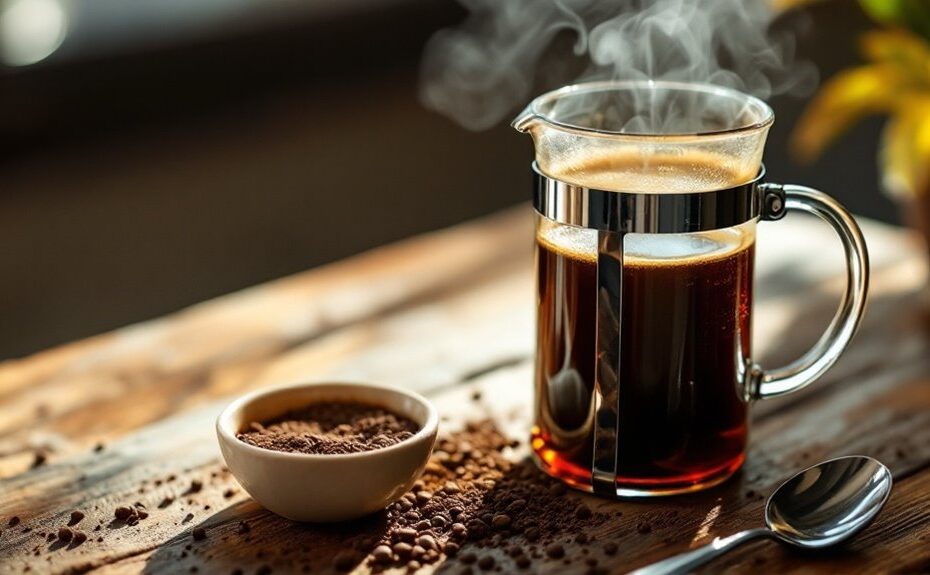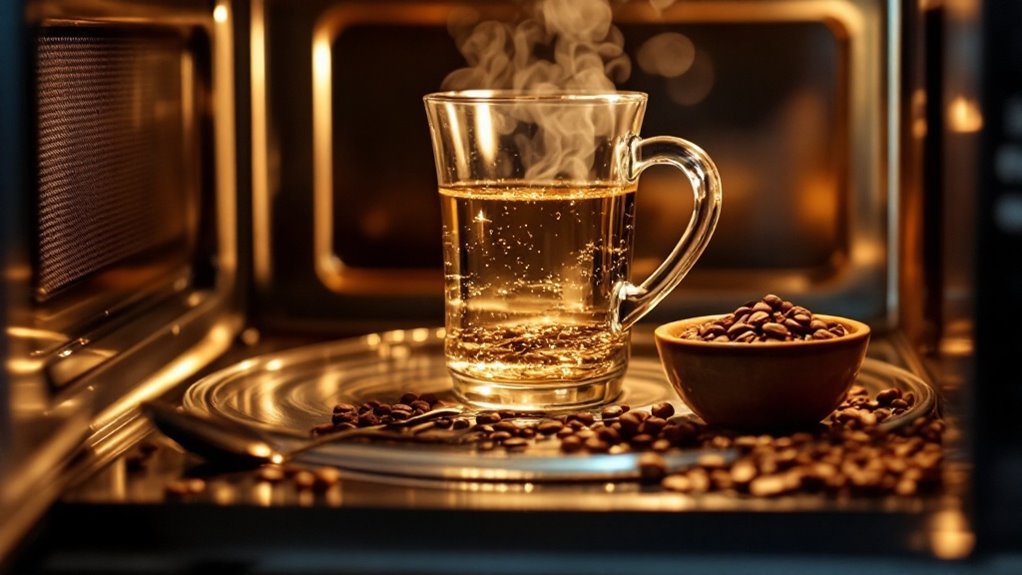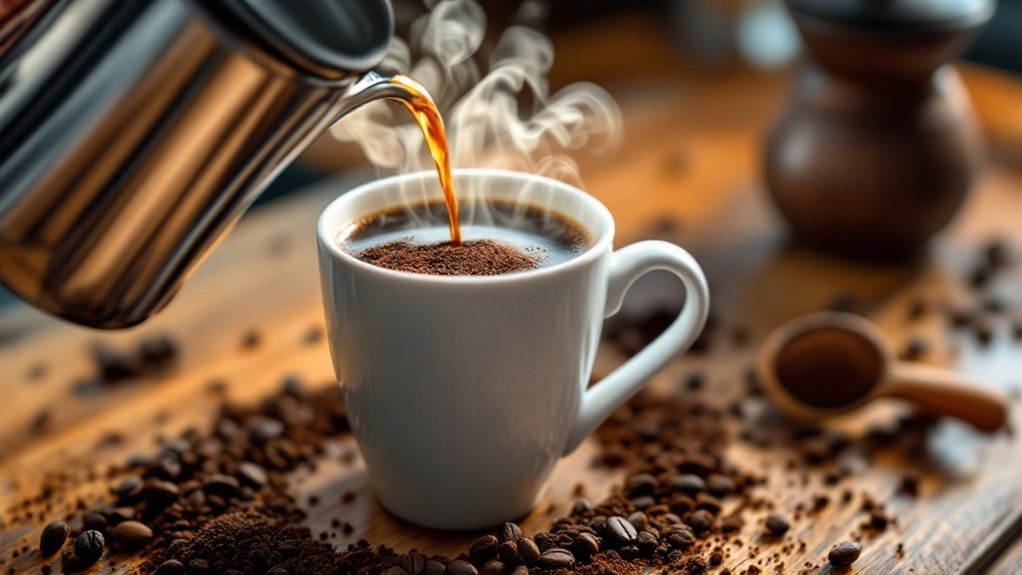







Adjusting the strength of your coffee isn't just about adding more grounds—it's a balance of ratios, grind size, and brewing methods. You might think a finer grind or longer brew time guarantees a stronger cup, but over-extraction can lead to bitterness. On the other hand, too little coffee or a coarse grind might leave you with a weak, underwhelming brew. The key lies in understanding how these factors interact and how to tweak them to suit your taste. But what if there's a simpler way to control strength without compromising flavor? Let's explore the nuances.
Key Takeaways
- Adjust the coffee-to-water ratio: Use 1:16 for stronger coffee or 1:18 for milder strength.
- Modify grind size: Finer grinds increase strength; coarser grinds reduce bitterness.
- Control brew time: Longer extraction yields stronger coffee; shorter times result in milder brews.
- Use post-brew dilution: Add hot water to brewed coffee to reduce strength without altering flavor.
- Experiment with ice-to-coffee ratios for iced coffee: More ice dilutes strength; less ice intensifies flavor.
Understanding Coffee Strength Basics
Understanding coffee strength starts with recognizing that it's determined by the percentage of dissolved coffee solids in your brew. For example, drip coffee typically contains around 1.25% dissolved solids, while espresso can reach up to 10%. The key to controlling coffee strength lies in your brew ratio—the precise measurement of coffee grounds to water. A higher ratio of coffee grounds to water increases the concentration of dissolved solids, resulting in a stronger cup. Conversely, using fewer coffee grounds or more water dilutes the brew, making it weaker.
To achieve balanced flavor, aim for an extraction percentage between 18-22%. Under-extraction, below 18%, leads to sourness, while over-extraction, above 22%, causes bitterness. Adjusting your brew ratio is the most direct way to influence strength without altering grind size or extraction time. For instance, a 1:15 coffee-to-water ratio (1 gram of coffee to 15 grams of water) is a common starting point for drip coffee. Experiment with ratios like 1:12 for a stronger brew or 1:17 for a lighter one. Remember, strength isn't about roast level or caffeine content—it's about the concentration of coffee solids in your cup.
The Role of Grind Size in Strength
Grind size plays a significant role in determining the strength of your coffee by influencing how much flavor is extracted from the grounds. Coarse coffee grinds result in less surface area exposed to water, leading to weaker coffee with milder flavor. Conversely, fine grinds increase extraction, producing a stronger coffee with more intense flavors. For example, a French press requires a coarse grind to prevent over-extraction and bitterness, while drip coffee performs best with a medium grind for balanced strength. Using a burr grinder guarantees consistent grind size, allowing you to fine-tune your coffee's strength effectively. If your coffee tastes weak, try grinding your beans finer to increase extraction. If it's too bitter or over-extracted, opt for a coarser grind. Adjusting grind size is a straightforward way to control coffee strength without altering the coffee-to-water ratio. By mastering grind size, you can tailor your brew to achieve the perfect balance of strength and flavor for your preferred brewing method.
Adjusting Coffee-to-Water Ratios
The coffee-to-water ratio is a critical factor in determining the strength and flavor profile of your brew. Start with a standard ratio of 1:18 (1g coffee to 18g water) and adjust incrementally to suit your taste. For stronger coffee, increase the amount of coffee grounds while keeping the water constant, aiming for ratios like 1:16 or 1:15. Avoid exceeding a 1:16 ratio, as this can lead to under-extraction and sour flavors. Use a scale to measure your coffee and water precisely, as even small changes in the ratio can substantially alter the strength and flavor of your brew. Different brew methods may require specific ratios; for example, a French press typically works best with a 1:16 ratio, while espresso uses a much stronger 1:2 ratio. Experiment with these adjustments to find the perfect balance for your preferred brew method and desired strength. By fine-tuning the ratio of coffee to water, you can achieve a consistently satisfying cup tailored to your taste.
Brewing Methods and Their Impact on Strength
Espresso machines produce a concentrated, bold coffee with a 1:2 coffee-to-water ratio, while drip coffee makers yield a milder strength at a 1:18 ratio. French press brewing, using a coarse grind and a 1:16 ratio, extracts rich, full-bodied flavors due to its longer steeping time. Each method's grind size, water contact, and pressure directly influence the final strength and flavor profile of your coffee.
Espresso vs. Drip Strength
Espresso's strength comes from its 10% dissolved coffee solids, achieved through a fine grind and high-pressure extraction in just 25-30 seconds. This method uses a 1:2 coffee-to-water ratio, producing a concentrated 30ml shot with bold, intense flavors. In contrast, drip coffee relies on a medium grind and gravity for extraction, taking 4-6 minutes to brew. It uses a 1:16 to 1:18 coffee-to-water ratio, resulting in a milder 240ml cup with 1.25% dissolved solids. While espresso delivers caffeine quickly due to its concentrated form, drip coffee provides a similar total caffeine amount over a larger volume, making it less intense per sip. The shorter brew time of espresso enhances its robust, syrupy texture and complex flavor profile, while drip coffee's longer extraction yields a smoother, more balanced taste. If you prefer a strong, quick caffeine hit, espresso is ideal. For a gentler, larger serving, drip coffee suits your needs. Adjusting grind size, brew time, and ratios in these methods lets you fine-tune strength to match your taste.
French Press Extraction Levels
French press brewing offers a distinct approach to coffee strength, relying on full immersion and a coarse grind to extract rich, bold flavors. To achieve ideal extraction, use a 1:16 coffee-to-water ratio—for example, 30 grams of coffee to 480 grams of water. Brew for 4 to 6 minutes, adjusting the time to control strength. A shorter brew (under 4 minutes) may result in under-extraction, yielding weak, sour flavors, while over-extraction (over 6 minutes) can lead to bitterness. For a stronger brew without altering time, adjust the ratio to 1:15 or 1:14, increasing the coffee concentration. The French press's full immersion method extracts more oils and solubles, creating a fuller-bodied, robust cup. Use a consistent grind size—coarse, like sea salt—to prevent fine particles from slipping through the mesh filter, which can muddy the flavor. Experiment with ratios and brew times to fine-tune your preferred strength, balancing boldness with smoothness. The French press's simplicity and flexibility make it ideal for crafting a strong, flavorful brew tailored to your taste.
Extraction Percentage and Flavor Balance
To achieve a balanced cup of coffee, understanding extraction percentage is key. Extraction refers to the amount of soluble compounds dissolved from coffee grounds into water during brewing. Ideally, you want to extract 18-22% of the coffee's soluble material. Below 18%, your coffee will taste sour and underdeveloped, as not enough flavor compounds have been dissolved. Above 22%, you risk over-extraction, which pulls out bitter flavors and astringent compounds, making the brew unpleasant.
Grind size, brew time, and water temperature are critical factors influencing extraction. A finer grind increases surface area, speeding up extraction, while a coarser grind slows it down. Brew time also plays a role—too short, and you'll under-extract; too long, and bitter flavors dominate. Water temperature should stay between 195°F and 205°F for ideal extraction. Cooler water under-extracts, while hotter water can scorch the grounds, leading to bitterness.
Dilution Techniques for Controlled Strength
To control coffee strength, you can add water post-brew, adjusting the ratio to achieve your desired intensity without altering extraction. Bypass brewing lets you dilute coffee by adding water around the grounds, maintaining flavor balance while reducing strength. For iced coffee, flash-chilling preserves flavor by rapidly cooling the brew, then diluting it to balance strength and avoid bitterness.
Water Addition Post-Brew
By adjusting the amount of water added after brewing, you can fine-tune the strength of your coffee without changing the extraction process. If your brewed coffee is too strong, simply add hot water to dilute it. For example, if you've brewed a concentrated batch, adding 30-60ml of hot water per 240ml of coffee can balance the strength while preserving the flavor profile. This method is particularly useful when brewing iced coffee; brew a double-strength batch and dilute it with ice to achieve the desired strength and temperature. Similarly, an Americano is made by adding hot water to espresso, reducing its intensity while maintaining its rich flavor. When diluting, use precise measurements to avoid over-dilution, which can flatten the taste. Start with small increments of water, taste, and adjust as needed. This approach allows you to control the strength without altering grind size, brew time, or other brewing parameters. By mastering post-brew dilution, you can consistently achieve your preferred coffee strength, whether you're aiming for a bold or milder cup.
Bypass Brewing Method
The bypass brewing method lets you fine-tune your coffee's strength by adding water directly to the brewed concentrate, ensuring precise control without altering the extraction process. When brewing coffee, the contact with water during extraction determines the flavor and strength of the final cup. By using bypass brewing, you can adjust the strength after brewing by diluting the concentrate to your preference. For example, if you've brewed a stronger coffee but find it too intense, simply add hot or cold water in small increments—start with 10-15% of the total volume—and taste as you go. This technique preserves the original flavor profile while reducing intensity, making it ideal for large batches where consistency is key. Avoid over-diluting, as it can mute the coffee's complexity. Bypass brewing is particularly useful for creating balanced Americanos or ensuring uniform strength across multiple servings. By mastering this method, you gain flexibility in brewing coffee without compromising on quality or flavor.
Flash-Chilled Iced Coffee
Flash-chilled iced coffee offers a quick and effective way to control strength by brewing hot coffee directly over ice, instantly cooling and diluting it. To achieve a balanced strength, use a 1:1 ratio of brewed coffee to ice. For a milder cup of coffee, increase the ice, which dilutes the brew further. If you prefer a Coffee Strong flavor, reduce the ice or pre-chill your coffee before pouring it over ice to minimize melting and maintain intensity. Cold brew concentrate can also be flash-chilled by diluting it with ice and water, allowing you to adjust how much coffee flavor you want. Experiment with brewing methods like drip or French press to fine-tune the strength and flavor profile. For example, a French press yields a richer, fuller-bodied cup of coffee, while drip brewing creates a cleaner, lighter taste. By controlling the ice-to-coffee ratio and brewing technique, you can tailor your flash-chilled iced coffee to match your preferred strength and flavor intensity.
Tools and Tips for Consistent Brewing
Achieving consistent coffee strength starts with precise tools and techniques. Use a 0.1-gram scale to measure coffee grounds and water accurately, guaranteeing the right coffee-to-water ratio for your brewing method. For a French press, aim for a 1:16 ratio, while an espresso machine requires a 1:2 ratio. Invest in a burr grinder to achieve uniform grind sizes, which are essential for balanced extraction and flavor. Adjust the grind size based on your coffee maker—coarser for French press, finer for espresso.
Time your brew meticulously to avoid over- or under-extraction. For a French press, steep for 4 minutes, and for espresso, aim for a 25-30 second shot. Experiment with grind size and brewing time to fine-tune strength and flavor without altering the ratio. A consistent grind from a burr grinder guarantees even extraction, while precise measurements and timing help maintain the desired flavor profile. Whether you're using a drip coffee maker or an espresso machine, these tools and techniques will help you achieve a consistently strong and flavorful cup every time.
Disclosure: As an Amazon Associate, I earn from qualifying purchases.







